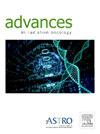Identifying Nutritional Inequities of Patients with Cancer Residing in Food Deserts
IF 2.2
Q3 ONCOLOGY
引用次数: 0
Abstract
Purpose
Nutrition is essential for cancer care, and patients who reside in food priority areas (FPAs) may experience limited access to healthy meals. There are few data evaluating the consequence of residing in FPAs because it relates to perceived food insecurity, psychosocial needs, or nutritional status of patients with cancer. This study aimed to determine the nutritional and psychosocial needs of patients with cancer who do and do not reside in FPAs.
Methods and Materials
From May 2019 to December 2022, a cross-sectional analysis was conducted using a validated questionnaire, offered at various time points before and after therapy, evaluating the psychosocial needs of patients with curable cancers. Groups were compared using X2 and Mann-Whitney U tests as appropriate. Binary logistic regression was used to identify predictors of food insecurity.
Results
Survey compliance was 74% (n = 320 of 434 patients). Patients who resided in FPAs (26%; n = 114) were more likely to self-identify as Black (60.5% vs 39.5%; P < .001), single (70% vs 37%; P < .001), and have a lower median income ($47,225 vs $91,305; P < .001) when compared with non-FPA residents. Residents of FPAs had a higher unmet nutritional needs index (median nutritional unmet needs score: 2.42 vs 2.00; P = .003), which included higher demands for healthier food choices (67.6% vs 54.4; P = .047) and greater food insecurity (44.4% vs 19.9%; P = .002). FPA residence was associated with a 3-fold increased risk of food insecurity (odds ratio [OR], 3.23; 95% confidence interval [CI], 1.59-6.57; P < .001). On multivariate analysis, predictors for food insecurity included Black race (OR, 9.46; 95% CI, 3.93-22.76; P < .001), stage (stage IV vs l OR, 4.27; 95% CI, 1.12-16.34; P = .034), and recurrent disease (OR, 10.26; 95% CI, 2.29-46.09; P = .002).
Conclusions
Inequities were identified in patients residing in FPAs, where race and higher stage were important predictors of food insecurity. Demographics can be readily used by clinicians to identify high-risk patients early in their cancer care in order to provide continuous nutritional resources to improve food insecurity perceptions. Future prospective studies are needed to confirm if such interventions improve cancer outcomes.
食物沙漠地区癌症患者的营养不平等
营养对癌症治疗至关重要,居住在食物优先区(fpa)的患者可能难以获得健康膳食。很少有数据评估居住在FPAs的后果,因为它涉及到感知到的粮食不安全、社会心理需求或癌症患者的营养状况。本研究旨在确定居住在和不居住在FPAs的癌症患者的营养和心理社会需求。方法与材料2019年5月至2022年12月,在治疗前后的不同时间点,使用经过验证的问卷进行横断面分析,评估可治愈癌症患者的心理社会需求。组间比较酌情采用X2检验和Mann-Whitney U检验。二元逻辑回归用于确定粮食不安全的预测因素。结果434例患者中,依从性为74% (n = 320)。居住在fpa的患者(26%;n = 114)更有可能自我认同为黑人(60.5% vs 39.5%;P & lt;.001),单身(70% vs 37%;P & lt;.001),收入中位数较低(47,225美元vs 91,305美元;P & lt;.001)。fpa居民的未满足营养需求指数较高(营养未满足需求得分中位数:2.42 vs 2.00;P = 0.003),其中包括对健康食品选择的更高需求(67.6% vs 54.4;P = 0.047)和更严重的粮食不安全(44.4% vs 19.9%;P = .002)。FPA居住与食物不安全风险增加3倍相关(优势比[OR], 3.23;95%置信区间[CI], 1.59-6.57;P & lt;措施)。在多变量分析中,粮食不安全的预测因子包括黑人种族(OR, 9.46;95% ci, 3.93-22.76;P & lt;.001),分期(IV期vs l OR, 4.27;95% ci, 1.12-16.34;P = 0.034),复发性疾病(OR, 10.26;95% ci, 2.29-46.09;P = .002)。结论fpa患者存在不公平现象,种族和较高分期是食物不安全的重要预测因素。临床医生可以很容易地利用人口统计数据在癌症治疗的早期识别高风险患者,以便提供持续的营养资源,以改善对粮食不安全的认识。未来的前瞻性研究需要证实这些干预措施是否能改善癌症预后。
本文章由计算机程序翻译,如有差异,请以英文原文为准。
求助全文
约1分钟内获得全文
求助全文
来源期刊

Advances in Radiation Oncology
Medicine-Radiology, Nuclear Medicine and Imaging
CiteScore
4.60
自引率
4.30%
发文量
208
审稿时长
98 days
期刊介绍:
The purpose of Advances is to provide information for clinicians who use radiation therapy by publishing: Clinical trial reports and reanalyses. Basic science original reports. Manuscripts examining health services research, comparative and cost effectiveness research, and systematic reviews. Case reports documenting unusual problems and solutions. High quality multi and single institutional series, as well as other novel retrospective hypothesis generating series. Timely critical reviews on important topics in radiation oncology, such as side effects. Articles reporting the natural history of disease and patterns of failure, particularly as they relate to treatment volume delineation. Articles on safety and quality in radiation therapy. Essays on clinical experience. Articles on practice transformation in radiation oncology, in particular: Aspects of health policy that may impact the future practice of radiation oncology. How information technology, such as data analytics and systems innovations, will change radiation oncology practice. Articles on imaging as they relate to radiation therapy treatment.
 求助内容:
求助内容: 应助结果提醒方式:
应助结果提醒方式:


